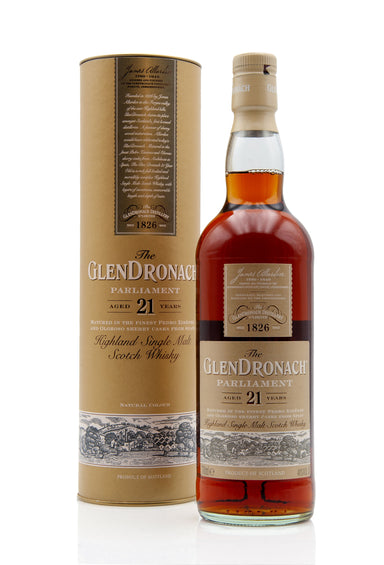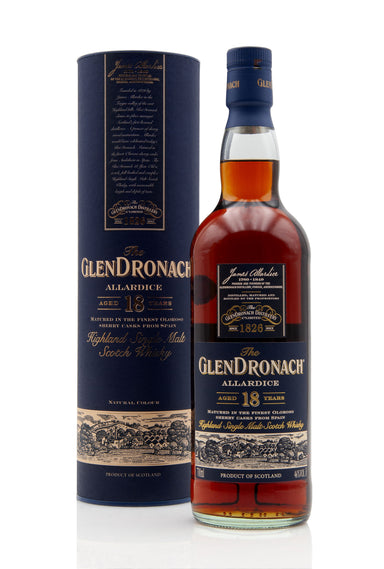
The GlenDronach 21 Year Old - Parliament
The GlenDronach Parliament, a excellent Highland whisky matured in a combination of the finest Oloroso and Pedro Ximenez sherry casks for a minimum...
View full details
Time has shown that GlenDronach is a survivor, while other distilleries in the North East of Scotland have faded into the history books, this iconic distillery continues to grow in...
Time has shown that GlenDronach is a survivor, while other distilleries in the North East of Scotland have faded into the history books, this iconic distillery continues to grow in popularity. It was established near Huntly in 1826, by a consortium of businessmen including the prominent James Allardice and local farmers. Taking its name from the Dronac burn that runs through the site, GlenDronach’s early years were hampered by financial constraints before a devastating fire in 1837 gutted most of the distillery. An entertaining tale exists of Allardice trying to sell his whisky to publicans in Edinburgh that involves ladies of the night and a flagon. It seems even in its infancy GlenDronach was already producing an exceptional whisky.
The distillery changed ownership in 1837, passing into the hands of Walter Scott (a former manager of Teaninich near Alness), until 1887. When Alfred Barnard visited the distillery sometime around 1886-1887, he was struck by its quaint and picturesque setting that included housing for the distillery workers, their families and the manager who resided at the main house. This impressive structure housed an array of trophies that Scott had won not for producing whisky, but breeding cattle. Barnard also commented that the GlenDronach malt was held in high regard on both sides of the border. Rumour has it that a room in Glen House is haunted by a Spanish lady who arrived via a sherry butt and has remained ever since, content with the odd dram.
In 1887 the distillery was purchased by the newly formed GlenDronach Distillery Company based in the port of Leith and remained in their hands until 1920 when Captain Charles Grant took over the reins. Grant of course was well versed in whisky matters due to his family establishing Glenfiddich. Unlike the iconic Speyside distillery, which remains under Grant ownership even to this day, GlenDronach was sold in 1960 to William Teacher & Sons who set about expanding their new acquisition.
The distillery is extremely photogenic, with most of the original buildings from the post-fire rebuild remaining intact although not all are currently in use. There is one exception to this picturesque setting and it’s the still house that was expanded in 1966, when the number of stills doubled to 4 and created an alien construction in a classical setting. Investment was required at GlenDronach to boost production for the popular Teachers Highland Cream and Royal Highland De Luxe whilst also supporting the existing 8 and 12-year-old expressions. Around this time Teacher’s stopped various GlenDronach bottlings including Huntly Royal, Old Vatted GlenDronach and Sir Walter. Despite doubling production output the distillery utilised direct fired stills until 2005 and the floor maltings were in operation until the 1996 when GlenDronach was mothballed.
Time stood still at the distillery until 2002, when production returned, followed by a period of stability until 2008 when ownership moved to the BenRiach Distillery Company. This marked a renaissance for GlenDronach as the enthusiasts praised the core range of age statement releases and annual special editions. In 2009 the whole range was relaunched with the addition of the excellent 21-year-old Parliament in 2011. Favouring various types of sherry wood, the new make spirit is in harmony with its host, thereby finding favour with many who were lamenting the decline of other distilleries who moved away from traditional sherry style bottlings. GlenDronach continued to innovate and introduced a peated expression in 2015, with a Sauternes finished release showcasing its adaptability.
In capacity terms and on paper GlenDronach is a minor player in the distillery heavyweight division, only producing 1.4 million litres annually, which is a fraction of Glenlivet, Glenfiddich and The Macallan. Despite this limitation, its profile and appreciation continues to rise and thus its value. In 2016, American corporate giant Brown-Forman, who count Jack Daniels amongst its range of spirits, made an offer that the BenRiach Company could simply not refuse. BenRiach, GlenDronach and Glenglassaugh were acquired for the impressive sum of £285 million.
Speculation is now rife as to what the future holds for GlenDronach and its sister distilleries. What is clear to many visitors touring the distillery in recent years is that investment at the site is required and as a whisky, GlenDronach offers huge potential that has not been fully realised. Brown-Forman have recently appointed Rachel Barrie as their Whisky Maker for Scotland, luring her from Morrison Bowmore Distillers where she was responsible for creating whiskies for Auchentoshan, Ardmore, Bowmore, Glen Garioch and Laphroaig. Watch this space for what happens next for GlenDronach.
 Sale
Sale
The GlenDronach Parliament, a excellent Highland whisky matured in a combination of the finest Oloroso and Pedro Ximenez sherry casks for a minimum...
View full details Sale
Sale
Named after the distillery's founder James Allardice, this superb Highland whisky from GlenDronach distillery has been exclusively matured in the f...
View full details
